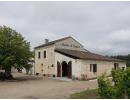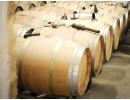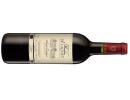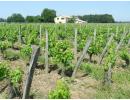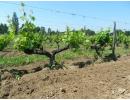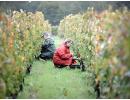Chateau Moulin de Lagnet
Château Moulin de Lagnet 2015 - Saint Emilion
The wine's blend is 80% Merlot with 20% Cabernet Franc, a yield of 45 hl/ha is produced from organically farmed vines averaging 35 years of age. The fermentations in stainless steel vats will last 3 weeks at 28°C, indigenous yeast are used. As for the ageing process, the two grape varieties are aged separately in the stainless steel vats for 10 to 12 months. The wine is estate bottled with a light filtration.
PVins notes: The wine shows an expressive unoaked nose of ripe fruit, cassis, Blackberry, licorice. Well structured on the palate, medium-bodied with a balancing freshness on the long finish. The wine may be cellared for up to 10+ years depending on the vintage.
Wine Enthusiast 88
This blend of 80% Merlot and 20% Cabernet Franc is ripe, showing red-berry flavors and an excellent potential. Made from organically grown grapes, it is perfumed and richly fruity, with spice and juicy acidity at the end. Drink from 2021.
Château Moulin de Lagnet is located in the in the commune of Saint Christophe des Bardes situated 2.2 kilometres north-east of the village Saint-Emilion. The estate has a long history with its 17th century building, it was a place of passage and meeting with the mill nearby. Since the 19th century, the Château's vineyard extend over 9 ha in a single holding protected by natural hedges. In 1984, Anne-Lise Goujon representing the 5th generation and her husband Pierre Chatenet decided to take over her family's property which was somewhat rundown. They invested a lot of time and hard work in bringing the estate back to quality. They renovated the cellar and gambled to implement organic farming which has since paid off in the regularity of the wines produced. The estate is certified organic since 2001. Since 2008, their eldest son Olivier Chatenet, now 6th generation, brings a new approach to the work in the vineyard. Following his diplomat in viticulture and oenology his new approach is based on herbal medicine and bio-dynamic farming.
Château Moulin de Lagnet has earned a reputation for its reliability in quality. It has won the Saint Emilion Cup back to back which is held every two years based on 3 vintages. In 2013 it won the cup for the 2007, 2008, 2009 vintages and in 2015 for the 2010, 2011, 2012 vintages. Following the 2015 award, Anne-Lise said "for us what is important is the perception of terroir. All the work, from the vineyard to the cellar, is made to respect it".
Château Moulin De Lagnet has a total of 9 ha as a single vineyard, its altitude is at about 42 metres. In 1995, Anne-Lise and her husband Pierre decided to produce a Saint Emilion Grand Cru from old vines averaging 50 years of age representing 1.50 ha. The estate's main wine, the cuvée Saint Emilion, represents 7.50 ha with vines averaging 35 years of age. The vineyard is mainly planted with Merlot (80%) complemented by Cabernet Franc (20%). The soil is of clayey-sand in structure with a limestone subsoil.
The vineyard is certified organic since 2001, but with the participation of Olivier Chatenet since 2008, some bio-dynamic principals are now applied to the work in the vineyard. Green canopy management and green harvesting are implemented when necessary and the harvest is handpicked.
Firstly the grapes are hand-picked at full maturity producing an average yield of 45 hl/ha. A first sorting is done in the vineyard and a further sorting is done on arrival at the cellar using 2 sorting tables, the grapes are then destemmed. The wine's blend is made up of 80% Merlot and 20% Cabernet Franc. The fermentations in stainless steel vats will last 3 weeks at 28°C, indigenous yeasts are used. As for the ageing process, the two grape varieties are aged separately in the stainless steel vats for 10 to 12 months. The wine is estate bottled with a light filtration.
Having the Merlot as the dominant grape the wine's tannins are elegant and fine, as there is no barrel ageing in the winemaking process so the grape characteristics are well expressed. It is pleasant to drink in its youth but has a potential to age over a decade. Château Moulin de Lagnet has earned a reputation for its reliability in quality. It has won the Saint Emilion Cup back to back which is held every two years based on 3 vintages. In 2013 it won the cup for the 2008, 2009, 2010 vintages and in 2015 for the 2010, 2011, 2012 vintages.
As for the Saint Emilion Grand Cru produced by the château, it follows the same winemaking process as above. The differences are: the wine is made with 100% Merlot from 50 years old vines and the ageing will last for 24 months in French oak barrels.
Links: AOP Saint Emilion - Libournais map - Bordeaux map
SAINT EMILION
The appellation Saint Emilion was created in 1936 situated in the Gironde department. It is located some 40 kilometres northeast of the city Bordeaux on the right bank of the Dordogne river in the sub-region of Libournais. Its famous neighbour is the appellation of Pomerol. The vineyards cover about 5,200 hectares spreading over nine communes. Only red wines are produced in the appellation giving some of Bordeaux’s best Merlot based wines such as Château Cheval Blanc, Château Ausone and Château Angélus, just to name a few, are found here. Since 1955, Saint-Emilion has its own Grand Cru Classé classification which is revised every 10 years, the most recent classification being 2012. There is also a "Grand Cru" status which any wine can claim as long as they are produced according to the Saint Emilion Grand Cru appellation criteria. The village of Saint Emilion and its surroundings were added to the list of UNESCO’s World Heritage Sites in 1999.
History
Viticulture in the area can be traced back to the Roman times. The famous Roman poet and teacher Decimius Magnus Ausonius (AD 310 - 395) had an estate that supposedly included the land now owned by the famous Château Ausone, which takes its name from him. There is a legend that tells us about a monk from Brittany who fled from Vannes, his hometown, to seek refuge in one of the natural caves in a place called Ascum bas (former name of the village) in the 8th century. His name was Emilion. Living the life of a hermit he accomplished a few miracles and rapidly became famous in the region and even far beyond its borders. Soon he had many disciples and the village became a great religious centre. Even after his death his followers carried on his legacy and even called the town after him: Saint-Emilion. Today, if Saint-Emilion wines are world famous it’s also thank to the hard promotion work of the "Jurade", a wine brotherhood that was created in 1199 by John King of England as the region was under English rule. He delegated his economic, political and legal powers to the noblemen of the region and the village. In 1789, the authority of the Jurade was contested during the French Revolution, but in 1948 a few winemakers resurrected the brotherhood which is now in charge of promoting the Saint-Emilion wine around the world.
Vineyard
The topography of Saint-Emilion is slightly hilly with a plateau and hillsides which helps the drainage in certain types of soil. Most of the classified Grand Cru Classé (Growth Wine) properties are set on the plateau around the village with its Tertiary era limestone bedrock or on south facing slopes.
There are three types of soils in the appellation:
- The plateau: clay-calcareous rich with decalcified loamy clay in some areas.
- The slopes: upper part is clay-calcareous rich on a soft limestone bedrock and the lower part is sandy-clay and loam with sedimentary bedrock.
- The plain: sand and gravel from alluvial deposits during the recent Quaternary era.
The Merlot is king here as it is well suited to the clayey-limestone soil and cooler climate, compared to the Médoc on the left bank of the Gironde Estuary. It is often blended with Cabernet Franc and sometimes Cabernet Sauvignon. The Merlot offers incomparable aromatic richness, colour, suppleness and crispness on the palate. Its bouquet immediately releases aromas of ripe red and black fruit and flowers, developing into fig or plum notes after a few years of cellaring. The Cabernet Franc with its fresh bouquet and tannins offers a perfect structure and ageing potential. As for the Cabernet Sauvignon, it is well-suited to hot and dry soils, it offers spicy notes and rich tannins that will give the wine structure, enabling it to age well for a long time.
Climate
The Libournais region benefits from the temperate oceanic climate from the Atlantic Ocean. It is marked by moderate temperature differences between summer and winter, with rainfall well distributed throughout the year. Hot summers, warm autumns and protection from the Dordogne river minimising the risk of frost, are all favourable elements for a perfect ripening of the fruit. However, this microclimate remains subject to climatic variations. From one year to another the differences in temperature and rainfall can be significant, therefore influencing the quality of the vintage.



